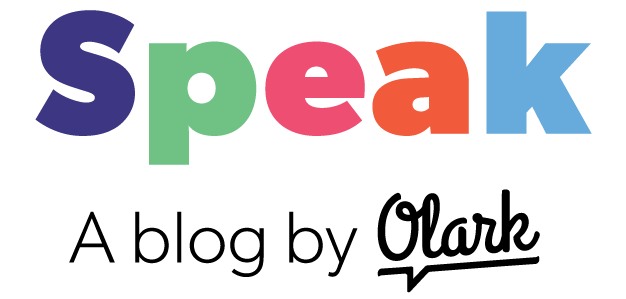When Olark was founded, way back in 2009, most businesses offered one of two basic online communication options: email and web forms. There have been a lot of changes since then! Today, businesses communicate with customers not just via live chat, but also via online messaging, social media, and more.
With this relatively new variety in communication options, we’re getting more questions about the top benefits of live chat over other forms of messaging. In a world of many competing systems and products, it can be hard to figure out which are right for you, your business, and most importantly, your customer.
Top benefits of live chat vs. other online communication
1. Your customers value transparency
Have you ever tried to cross a “quick” task off your list — say, scheduling a haircut or a doctor’s appointment — and ended up in an hours-long game of voicemail tag? Or called your best friend with the most exciting news ever...and gotten their answering machine?
We hate that feeling, and we figure our customers probably do, too. We never want anyone to think they are about to have a conversation, only to get a response telling them their message will be answered shortly. That’s why we love the fact that live chat lets our customers know if a human is actually standing by to answer their question, or if they should drop us an email and expect a bit of a wait.
2. You need to solve a problem quickly
Asynchronous conversations can literally drag on for days. One of our agents, SarahB, actually did a study into the relative speed of resolution in chat versus email, using the example of customers who’d forgotten to cancel their subscriptions and needed a refund. That problem took a whopping 19 hours to resolve via email, compared to 4.5 minutes over chat. It’s not just the lag time between replies that slows things down, either — the ability to see a customer’s account in the moment, and to give and receive immediate feedback as they try various fixes or options, cuts down dramatically on miscommunication and confusion.
I started my career at Olark answering what we call the “overnight” emails. Since we don’t provide chat on our site 24/7, our offline message form does the heavy lifting while our North American team is snoozing. I am UK based, and so I would clear the inbox in my morning to ensure that European customers got a quick response and American customers had responses in their inboxes by the time they woke up.
That method worked fine, and it still does, but I can’t begin to tell you how often I got 5 emails deep in a chain and thought, “I wish we could just chat about this, it would help so much.”
3. You really want to connect with your customers
Real-time chat encourages real conversations. Think about it — does it feel more natural to ask open-ended questions about someone’s experience with your product in a live chat, or an asynchronous message exchange?
With chat, you can quickly tell whether a customer is frustrated, or whether they have a sense of humour. You can ask them about their day, and make the interaction personal in a way that is trickier over email.
For example — my chat profile picture has an image of a hen on my head. As you might imagine, I’ve gotten some questions from customers about that, leading to side conversations about farming and animals. I once got tips from a customer on how to improve the laying rate of my hens. Did that solve his issue? Not that part of the conversation, no, but I benefited from getting to know him a bit better, and an initially awkward conversation become a real pleasure. And yes, we did resolve his issue in that chat. The hens continue to lay intermittently.
Live chat vs. other online communication
How it works: Pretty simple — you add your email address to your website, and people can use it to contact you. A contact form embedded in your website can also route customer messages to your email system, without actually giving out an address.
- Pros:
- Almost everyone knows what email is and how to use it
- Assuming you check your email and make use of filters and forwarding, it’s fairly easy to get the message to the right person
- You don’t need to worry about having someone around to reply instantly
- Cons:
- Your reply to the customer can get lost in spam filters
- If a customer enters their email address incorrectly when using a form, there is no way of replying to them
- Long email threads are a navigation and comprehension nightmare
- Customers don’t know when to expect a response — emailing a business can feel a bit like casting a message into a black hole
Online messaging
How it works: You purchase a software subscription that adds a small box or button to your webpage, inviting customers to leave you a message.
- Pros:
- Low effort for the customer
- Your website looks friendly and invites interaction, which is good for sales
- You don’t need to worry about having someone around to reply instantly
- Cons:
- Just like email, customers have no way of knowing when you’ll reply
- If the widget looks like a chat box, customers may be frustrated when they discover that they need to wait for a response; if there is an estimated long wait time, or a “last seen” date from a few days ago, it can be even more disappointing
Live chat
How it works: You purchase a software subscription that adds a small box or button to your webpage. The box or button only gives customers the option to chat with you when you’re actually online and available. Otherwise, it shows an offline message form.
- Pros:
- Transparency — customers know when you’re available, so they have a better sense of how quickly you’ll respond
- Efficiency — real-time communication is the fastest way to resolve problems and address complex product questions
- Human connection— live chat feels like a real conversation, so you can establish the same kind of rapport you’d expect with face-to-face interaction
- Cons:
- You need someone available in real time to answer chats
- Because chat is faster-paced than asynchronous communication, agents need to be able to respond to questions quickly
Since live chat is our area of expertise, we’ll dive into the points above a little more depth.
Staffing
Live chat does require you to have someone available in real time, so you need to consider staffing needs a bit more than with some other channels.
However, there’s no requirement that you offer chat round the clock. Even here at Olark, as I mentioned before, we don’t use chat 24/7. We have made a conscious choice about that — we want Olarkers to have a good work life balance and not work into the night. We’ve found that as long as we’re clear about our chat support hours, visitors aren’t disappointed to find that we’re not always online. In fact, they appreciate the clarity.
Speed
Real-time conversation is a bit of a double-edged sword — issues get resolved more efficiently, but agents also have to be prepared to respond quickly to almost any question or request.
At Olark, we’ve addressed this challenge by making sure our agents have quick access to anything they might need to respond to a customer. That includes the customer’s account details, of course, but also input and advice from the rest of our team — our engineers, product managers, and sales and marketing staff all pitch in regularly to help with customer questions.
Should you use live chat?
Well, we think yes! Live chat is awesome when:
- Your customers value transparency: Chat is more transparent — you’re not led to believe someone’s there when they’re actually not going to respond until tomorrow
- You need to solve a problem quickly: Chat is faster — an async messaging conversation could literally drag on for days
- You really want to connect with your customers: Real-time chat encourages real conversations
Of course, the real-time nature of live chat can make staffing and agent support just a wee bit trickier. However, Olark is working to change that! Check out our 2018 year in review to learn more about what we’re doing to make real-time, real-people conversations more efficient and effective, from team management tools, to visitor insights, integrations, accessibility, and more.
We're running a series on Making Business Human. Fancy getting involved?
Photo by Adam Solomon on Unsplash

